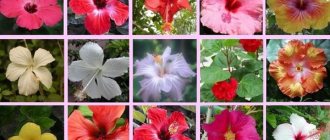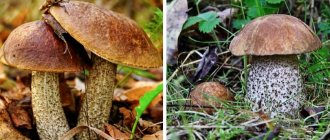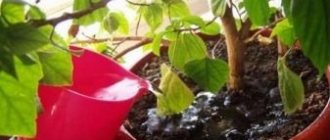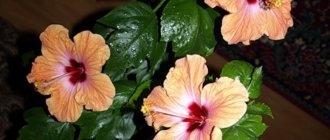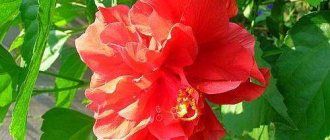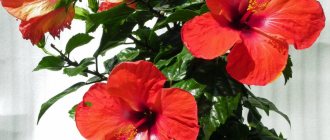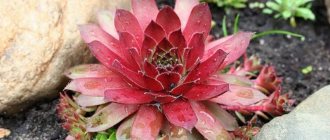Hibiscus or Chinese rose - an indoor plant with flowers of amazing beauty, fairly long flowering and overall visual appeal.
Dear readers! For you, we have created communities on social networks in which useful articles and interesting ideas are published several times a day! Subscribe and receive useful content in a convenient format!
However, hibiscus with its special beauty could have been much more popular if not for the numerous superstitions and signs that have surrounded it for a long time. The most popular epithet given to the Chinese rose is “flower of death.” Of course, such a terrifying name cannot carry anything good.
We have made this article by collecting all the popular and lesser known facts about hibiscus. Some of them are superstitions that have been established for centuries. Others are dubious assumptions. But, in any case, we assure you that this plant is so beautiful that even not the most rosy signs can be left to the mercy of the past, when people believed in sorcerers and magic, and today you can simply grow one of the most beautiful and exotic in appearance at home flowers.
What signs and superstitions are there?
- For example, on the islands of Haiti, hibiscus is considered a symbol of beauty and purity. When the plant blooms, it is customary to photograph the plant for good luck and decorate the home with it and its images. Finally, hibiscus is one of the classic souvenirs for all holidaymakers on the islands.
- Hibiscus is more often called Chinese rose in countries such as China, India, Malaysia, Indonesia. In all these states, it is common for people to venerate the flower as a symbol of purity and happiness in love. In Malaysia, girls weave buds into their hair, emphasizing their beauty and youth.
Girl with a flower
- In Southern China, India and Indonesia, the Chinese rose is an obligatory attribute of wedding ceremonies.
FUN FACT: Hibiscus can be seen on the coat of arms of Malaysia. And in the capital of the country, Kuala Lumpur, there is a whole park in which there are more than 2000 species and varieties of this plant. It is customary to hold marriage ceremonies in the park.
- In Brazil and Argentina, hibiscus has long been a symbol of fertility. Initially, it was grown in homes in order to increase the yields of their plantations. Today the plant is strongly associated with the addition to the family. In Brazil, for example, hibiscus is given to married couples so that they can have children as quickly as possible. In Argentina, it is customary to grow different varieties of hibiscus to maintain family happiness. In most families, it is customary to keep at least 3 different hibiscus plants in the house.
However, among some peoples, hibiscus is considered a symbol of death. Unfortunately, it is this name that has especially taken root in the minds of most gardeners and therefore repels them from the opportunity to have this plant at home.
Is it possible to plant a flower in the garden?
Chinese hibiscus is a fastidious plant that feels good only in a certain temperature range - from 12 to 25°C. In this regard, in the northern regions of the Russian Federation it is grown only at home or in greenhouses. To prevent the death of the rose, it is grown as a tub plant.
Landing Features:
- Tub sizes. The plant reaches a height of 3 m, so a container with a diameter of at least 35-40 cm and a height of 40-50 cm is selected for it. Preference is given to tubs made of wood.
- Features of landing. When transplanting, the hibiscus is placed in a tub with an old lump of earth. Expanded clay or large crushed stone must be placed at the bottom, which will act as a drainage cushion. In order for the plant to take root, use fertilized soil with sufficient humus content.
- Optimal conditions. Before flowering, the flower pot is placed in a well-lit place on the site, but not in direct sunlight. It is not recommended to move the tub while throwing out the buds.
Chinese hibiscus does not tolerate frost. If the temperature drops below 12°C at night, take the shrub home. If this is not done, the leaves will quickly turn yellow and the flowers will fall off.
For those who do not want to bother with the annual transportation of a heavy tub, a garden (Syrian) rose is suitable. She throws out multi-colored funnel-shaped buds of red, pale blue, white and other colors. Unlike Chinese hibiscus, the plant is frost-resistant.
Why is hibiscus considered the flower of death?
There are strong superstitions that claim that nothing good can happen if a Chinese rose blooms at home. According to legends, this is a sign of death of the owner of the flower or one of his close people. This is where the name “flower of death” comes from.
Of course, there are simply no real stories confirming this fact. And all the existing legends that are associated with this plant are in the rank of tales, legends and scary stories.
Some esotericists and mystics argue that not every hibiscus blossom can be considered a sign of death, but only those that fall on uncharacteristic dates (in this case, it can be argued that the sign has special power). Traditionally, hibiscus blooms from May to November. In winter, this plant should normally be at rest.
The second bad omen lies in the fact that the Chinese rose suddenly drops its leaves. This is also sometimes interpreted as the speedy approach of a serious illness or even death.
Among some small Chinese peoples, hibiscus was strongly associated with death due to the red hue of its flowers. Now there are many varieties with other flower colors, but the epithet that has taken root with the Chinese rose still sits firmly in people’s minds.
Hibiscus care rules
Hibiscus needs light; in the shade it will shed its leaves. But direct sunlight is harmful to the leaves, yellowish spots will appear - burns. It is better to place the pot on a southern or eastern window sill, covering the window with tulle to diffuse the sun's rays.
Watering should be sufficient, but not excessive. Dry soil should not be allowed, but water should not stand. If the top layer has dried out by about three centimeters, it’s time to water. The ideal option is to use drip irrigation.
Hibiscus loves moisture, so you need to spray the plant periodically. It is better to do this in the morning so that excess water evaporates during the day. To moisturize, you can place glasses of water around the flower.
Like any plant, the Chinese rose needs fertilizer. Feed the flower a couple of times a month. This is especially important during the period of bud formation and flowering.
To make the flower grow more luxuriantly, you need to prune it in the spring. Be sure to remove dried and bare branches. And cut healthy ones by half. Trimmed healthy cuttings can be used for propagation.
Legends of hibiscus
A large number of legends are associated with the Chinese rose. They are mainly common in Asian countries.
- In the Eastern parts of Asia, there is a legend about how the popular hibiscus tea appeared there (hibiscus is another name for hibiscus, from the petals of which fragrant teas and tinctures are prepared). Once upon a time, a traveler got lost in the endless jungles of China and for a long time could not find a way out. When he was already overcome by hunger and thirst, he begged for any food when hibiscus petals fell into his pot of boiling water from somewhere above. The resulting tea turned out to be so aromatic, but most importantly, invigorating, that the traveler took several flowers with him and soon found a way out to people and shared a new drink with them.
- There is a city in China, Chengdu, whose main symbol is the Chinese rose. It is believed that the first settlement on the site of today's metropolis was built on a very fragile foundation, which is why most of the houses soon collapsed. But the residents asked the magic turtle for help, who led them to special secret places, where he showed them how to build houses. The shape of the tracks of this turtle, along which people followed for new knowledge, resembled a hibiscus flower. That is why this plant became a symbol of the future city.
Hibiscus species
The plant has more than 250 species. The most popular are garden and indoor varieties.
Hibiscus hybrid
The large-flowered perennial hybrid was created by crossing two frost-resistant varieties (swamp hibiscus and armed hibiscus) with bright scarlet or bright crimson varieties. The leaves of the hybrid resemble maple leaves, and the flowers are similar in appearance to the Chinese rose, but have a more impressive diameter. On the territory of Russia it can be grown in gardens, but for the winter it requires careful shelter.
Swamp hibiscus
One of the most common types. The flower, 16 cm in diameter, is brightly colored with pink and purple spots surrounding the flower corolla. The variety is unpretentious, frost-resistant, and is used for borders and hedges. When grown in an apartment, the flower gives comfort to the home, and dried flowers have medicinal properties.
Syrian hibiscus
Syrian rose is a beautifully flowering perennial shrub that belongs to the tree varieties. The bush is powerful, spreading, reaches a height of 2.5 m, a width of up to 2 m. The leaves are arranged in a regular sequence and in their shape resemble a chrysanthemum leaf.
The bush is covered with single flowers up to 11 cm in diameter from mid-June to mid-September. Flowering is short-lived. Syrian hibiscus in regions with a temperate climate can be grown on a personal plot, since the bush tolerates frosts only down to −20 degrees.
Hibiscus Arnotti
A perennial tall shrub in natural conditions grows up to 10 meters and produces fragrant tubular flowers with eyes of various colors. The flowers are more than 10 cm in diameter; snow-white petals with soft scarlet or purple veins look harmonious against the background of green foliage. In temperate climates it is grown only as an annual. Propagated by cuttings.
Hibiscus spread
This type of plant is a shrub with thorny shoots and low-lying branches that bear large leaves and canary-colored flowers with a pink base. The variety got its name because of the curved shape of the crown: the branches from the trunk initially grow at an angle of 90 degrees, and then sharply rush upward.
Chinese rose
The Chinese rose flower is known to residents of temperate climates as a houseplant, and in the subtropics it is grown to decorate greenhouses, winter gardens and personal plots. The evergreen shrub reaches 4 meters in height. Large ovate leaves are attached to powerful branches by small cuttings. The flowers, reaching a diameter of 15 cm, have a wide variety of colors and shapes. Flowering is short-lived, but due to the formation of a large number of buds, the wilting of flowers goes unnoticed.
Is it a flower?
Enough contradictory information can be found about hibiscus as a plant that affects love relationships and further family happiness.
One thing is for sure. There are countries where it is customary for unmarried women to keep Hibiscus in the house (India, China, Malaysia, Indonesia).
In northern countries, most people believe that hibiscus can attract love into life, but it will not provide long-term happiness, since it has the qualities of a husband-growing plant. In many ways, this idea is associated with the negative energy of the flower, which charges mainly the male half of humanity with negativity.
FOR YOUR INFORMATION. Perhaps there is every reason to classify hibiscus as a typical and even very strong muzhegon. Here's a fact: for a long time in ancient times, this flower was used to create a celibacy crown.
What is hibiscus, what flower is called hibiscus?
The decorative flower hibiscus, or Chinese (Sudanese) rose, belongs to the mallow family. The shrub is native to China and northern Indochina. Due to its unpretentiousness, the plant has become widespread in countries with subtropical and tropical climates.
The word “hibiscus” means “ibis bird” (translation from Greek), hinting at the similarity of large inflorescences with a bird. A plant in spacious rooms can acquire enormous dimensions if it is not pruned, then each branch can produce a beautiful flower, while the decorative effect of the bush disappears.
The inflorescences come in red, pink, yellow shades, the type is double or regular, like a bell. The flowering period of any of them is two days. Fallen flowers can be used to brew special medicinal tea - hibiscus.
What does a plant mean in Feng Shui?
The teaching of Feng Shui, as you know, originated in China. It is as well-known a symbol of the Celestial Empire as the Chinese rose. According to the teachings of Feng Shui, the location of the hibiscus in the house is of great importance, and it directly depends on the shades of the petals.
- Hibiscus with yellow flowers should be placed in the south-eastern part of the house.
- On the western side there is a plant with white flowers.
- The most common option - hibiscus with red flowers - is according to the rules placed on the south side.
In the teachings of Feng Shui, it is precisely this arrangement of the Chinese rose that will benefit its owner and reduce to a minimum the mythical negative impact on the energy of the house.
History of a flower
The culture has several names, but the most famous are hibiscus and Chinese rose. In reality, there are more names, which is due to the distribution of the flower in the wild. For example, it can be found in different countries of the tropical zone of the planet under the names red sorrel, rose of Sharon, Venice mallow, hibiscus, etc. The idea of the plant also changed depending on the place where it grows, hence various legends.
For the first time, hibiscus became interesting as a flower in Hawaii: it was from here that it began to be imported en masse to European countries. At the beginning of the 18th century, the culture had already become an adornment of botanical gardens in Europe, attracting the attention of visitors with its lush flowering. In 1950, the hibiscus community was founded.
Is it possible to keep a flower at home?
Among most nationalities, hibiscus serves as the most important decoration at weddings; its flowers are woven into the hair of unmarried girls. On the other hand, this plant is not recommended for married couples to keep, as, according to legend, it can bring discord to the family.
INTERESTING FACT. Hibiscus, despite signs and superstitions, is an excellent helper for humans. Thus, a pulp ground from its leaves can be used to quickly treat burns and deep wounds. The resulting product perfectly helps relieve swelling, treats boils and ulcers.
According to another tradition, hibiscus is considered a vampire plant. That is, it takes away strength from a person. Therefore, it is not recommended to place the flower in the bedrooms. Another fact against this arrangement is the high energy potential of hibiscus. It is known that he can transmit this energy to others, charging them with vigor.
Benefits of the flower
Despite the huge number of bad omens associated with hibiscus, this plant is extremely useful. The point is not only in its decorative values, but also in some healing properties. Many of them are still actively used today. So, in the past, healers dried the flower petals and prepared a tea from them that could reduce blood pressure (Figure 3).
Note: Nowadays, some varieties of Chinese rose are actively grown in Egypt. Dried flower petals are used to prepare hibiscus tea, which is actively exported to many countries around the world.
In Arab countries, Chinese rose seeds were used as a seasoning or aromatic additive to coffee. It was believed that they were able to improve appetite, increase tone and have a beneficial effect on overall well-being.
If we talk about the modern world, scientists have already proven that the Chinese rose releases phytoncides into the air, which are ways to destroy certain pathogenic bacteria. This is why keeping hibiscus at home is not only possible, but also necessary.
What is treated with hibiscus
Most of the beneficial properties of the plant are associated with its petals. Tea made from them has many healing properties. Firstly, consuming hibiscus strengthens blood vessels and cleanses the body of cholesterol and fat deposits.
Figure 3. Healing properties of Chinese rose
Secondly, tea made from Chinese rose petals normalizes the functioning of the gastrointestinal tract, effectively copes with constipation and removes toxins, including heavy metals. In addition, hibiscus contains a lot of ascorbic acid, which has a pronounced antiviral effect and can serve as an effective means of preventing colds.
You will learn more interesting facts about the signs associated with hibiscus from the video.
Why does hibiscus bloom?
The most famous interpretation of hibiscus flowering is the approach of illness or even death of its owner. People also believe that the more luxuriantly this plant blooms, the more strength it takes from a person.
On the other hand, this theory is contradicted by the fact that the bad influence of flowering can only be perceived if it occurs at an unusual time (late autumn or winter).
Is it possible to keep hibiscus at home, care, reproduction and flowering
It is difficult to decide to grow an ornamental bush, since its second name is burnet. As the name suggests, the burnet tends to “drink all the blood” of its hosts during flowering. When the Chinese rose blooms, according to some beliefs, one of the household members may become seriously ill, or even die.
People free from prejudices calmly grow an exotic bush; it can even be located on a north window. For successful cultivation, a well-lit, frequently ventilated place is suitable. The optimal temperature for hibiscus is 20-22 degrees in summer, not lower than 14 degrees in winter.
For the best health of the sprout, constant growth, flowering, it needs abundant watering. In addition to watering, in the summer it is necessary to spray the bush and wipe the leaves with a damp cloth. However, you should not get carried away with excessive watering; if the water stagnates in the pan, this can lead to rotting of the roots. The best watering regime is every other day in summer, every four days in winter. The bush needs to be replanted every year until it reaches three years of age, then it can be replanted every two to three years.
Important! The tighter the pot, the slower the Chinese rose grows. In this way, the growth rate can be controlled.
Light soil, black soil with turf, is suitable for cultivation; this mixture is called “Garden soil”. A layer of expanded clay 2-4 cm high must be placed at the bottom of the pot for the best drainage. Without expanded clay, the plant may die as the roots rot.
Feeding the shrub is the usual chemical store-bought additives diluted with water. Feeding is carried out in the spring, from the beginning of March to the end of May, every two weeks during watering.
Indoor hibiscus is propagated by seeds or cuttings. Since the Chinese rose can easily be cultivated, its propagation by cuttings is a priority - this way you can preserve the entire individuality of the mother specimen. A cutting taken from the mother plant is placed in an ordinary jar or glass of water. The appearance of roots can be expected in two to three weeks. Some gardeners immediately plant cuttings in greenhouses without waiting for the roots. Both methods are convenient and almost always give results.
Homemade hibiscus does not produce seeds; after flowering, the flowers fall off without having time to create a capsule for the seeds to ripen. Growing a Chinese rose from seeds is very difficult and sometimes impossible for novice gardeners. In order not to be disappointed in growing, it is best to purchase cuttings of the plant.
What does the job promise?
If growing hibiscus at home can be called a dubious matter (especially if you believe the signs), then this plant is considered quite suitable for placement in work areas. First of all, because it can encourage a person to take action, develop energy and hard work.
Therefore, we can confidently say that it is permissible to grow hibiscus in offices, offices and other places where a person does not live but works. At the same time, the flower is not considered capricious, which means caring for it will not require much time and effort.
Garden hibiscus - is it a good flower for the garden?
Garden hibiscus, or Syrian rose, is a beautiful flowering shrub that will decorate any corner of your garden plot. Garden hibiscus grows very slowly; an adult plant can reach 3 meters in height. Propagated by cuttings. The variety is frost-resistant and does not require shelter in the southern regions. In regions with harsh winters, the plant is transplanted into tubs for the winter and stored in the basement.
The Syrian rose is an indispensable assistant for decorating a summer cottage. Thanks to its beautiful flowers, garden hibiscus has become an addition to the landscape design of a personal plot in regions with a temperate climate. The plant is used to decorate arches, it is used to form hedges and borders, and the Syrian rose, planted close to each other, provides good protection from gusty winds. Hibiscus will decorate a corner of the garden only if you put a lot of effort into planting and caring for the plant.
How to neutralize negative meanings?
If you can’t help but get hung up on ancient legends and not pay attention to the well-known name of the Chinese rose as the flower of death, then, of course, it is better to refuse this plant in your home.
In Ancient China, they believed that the Chinese rose blooms especially intensely when someone dies in the house. People believed that the plant took the energy of a person into itself (another sign why the Chinese rose is considered the flower of death). In this case, the hibiscus was dug up and burned. They did the same if long-term illnesses unexpectedly began in the house.
What kind of flower is hibiscus: a brief botanical information
Hibiscus belongs to the Mallow family. Southern China is considered its native country, hence the plant got another name - Chinese rose. The first discovery of this plant occurred in the Hawaiian Islands, from where it was brought to Europe and then to America.
Hibiscus is also highly revered in Argentina. The Argentine people consider it bad form not to have this wonderful flower in your home. Malaysia is proud of its parks and gardens decorated with these wonderful flowers. The Haitians have proclaimed the Chinese rose as the symbol of their island. They decorate themselves and tourists with wreaths of this beautiful flower.
An evergreen shrub with good care grows up to several meters. The stem of the plant is bare, and the dark green leaf plate is located on the petioles. Large brightly colored flowers of various shades reach a diameter of up to 25 cm.
Determine the name of a garden flower from a photo. In a special publication on our portal we will talk in detail about various garden flowers. You will familiarize yourself with the catalog, a large photo gallery and learn many types of garden flowers.
conclusions
So, we managed to find out that hibiscus is called the flower of death only in tales and legends. To some extent, these are just ancient myths that are hardly worth believing much. Still, not a single plant is capable of taking energy from a person, much less leading to his death. And all the existing stereotypes are most likely just a series of fatal accidents (and even then there are very few of them, many of them are far-fetched).
By the way, in defense of the flower, we note that with proper care, all its influence is considered invalid. After all, if the hibiscus blooms strictly at the designated time, and also does not shed its foliage en masse, then it can turn out to be quite an interesting and beautiful house plant without any unkind signs.
However, we can give advice - if you get hung up on the well-known epithet of hibiscus, it will not lead to anything good. Therefore, we definitely do not recommend planting this flower at home for overly superstitious and impressionable people.
Is it possible to keep a Chinese rose at home?
No one can tell you exactly why you can’t keep Chinese hibiscus at home. Although it is considered the flower of death, statistical data is stubbornly silent. If you are not used to blaming others for what is happening in your life, then feel free to get a Chinese rose.
5 reasons to keep hibiscus in your apartment:
- pleasing to the eye;
- purifies the air;
- blooms profusely;
- It does not require special care;
- exudes a pleasant aroma.
Those who believe in bad omens and are afraid that things will worsen in connection with the purchase of a plant should not get a hibiscus. This especially applies to people with a mobile nervous system, mental disorders and simply fatalists.
In Malaysia the flower is called Bungaraya. He is considered the symbol of the country, so his image is minted on coins in denominations of 5, 10, 20 and 50 sen.
Care
Hibiscus flower: what kind of plant, description, how to grow
Water the plant moderately, making sure that the soil does not dry out. Mulching the tree trunk circle with crushed bark or perlite will help. Constantly keep the soil slightly moist during dry periods, otherwise the buds will not hold. Sprinkling in the evening will be beneficial.
Feed in early spring, applying complex fertilizers for flowers, which contain at least 16% nitrogen. In summer, flowers need potassium. In August and September they fertilize with potassium-phosphorus preparations. In October, water with 30-40 liters of water, mulch with humus, and hill up. In the regions of central Russia, young bushes are later covered with spruce branches or burlap and spunbond.
Water the plant moderately
After spring feeding, the hibiscus is pruned. It is necessary to remove the branches that grow inside the bush and those that are damaged. Young shoots will grow quickly. Then the plant is formed by cutting off the branches by 1/3. The bush will become more lush and by summer it will produce large flowers that form on the shoots of the current year.
Additional Information. After possible slight freezing, the hibiscus quickly recovers and grows shoots.
Indoor maintenance includes:
- regular watering and spraying of the plant;
- organizing a dormant period in winter with temperatures up to 14-16 °C;
- highlighting a place with bright diffused light.
Street hibiscus: does it bring death?
Chinese, Sudanese rose is grown in gardens and on the streets of areas with a very warm, tropical climate. Those who believe in superstitions and signs are sure that the street plant also brings death to the owners of those homes near which this shrub grows.
Many people believe that the omens related to indoor hibiscus also have a negative effect when cultivating Chinese roses in gardens, front yards and on the street. In addition to the fact that the Chinese rose “pulls” the energy of the owner of the garden, it is rumored to be endowed with the ability to shorten the life of its owner. This statement is unsubstantiated and there is no point in believing it.
Hibiscus: cultivation and care (video)
Of the colossal number of varieties among Russian lovers of Chinese roses, the following have gained the greatest popularity:
| Variety | View | Description |
| Youth | Hybrid | Bright pink flowers with a white bottom have a shape reminiscent of tulips |
| Sanremo | Chinese | Pure white bell-shaped flowers set against dark green glossy foliage |
| Porto | Chinese | Flowers are red, uniform throughout the entire petal area. |
| Parple Majestic | Chinese | A very beautiful purple flower with white specks and a ruffled edge |
| Borias | Chinese | Lemon white, very large flower with a burgundy spot at the corolla and corrugated edges of the petals |
| William R. Smith | Syrian | Simple white flowers with a red center |
| Joan of Arc | Syrian | Terry large flowers, changing color from cream to snow-white as they bloom |
This is not a complete list of varieties that can be safely added to the list of classic inhabitants of Russian plots and houses. All of them are distinguished by relatively good resistance to unfavorable conditions, but for successful cultivation they require the vigilant care of the grower.
The Chinese rose is the flower of death, why is it considered so, what does the plant predict?
Many superstitious people are interested in why the Chinese rose is the flower of death and what this sign is connected with. During flowering, the evergreen shrub is decorated with bright red flowers.
Some say this is good, while others say it means family discord and illness. It is impossible to say for sure whether the Chinese rose (hibiscus) is a harbinger of events.
But our ancestors noticed many signs associated with this beautiful plant.
Why is hibiscus called the flower of death?
The Chinese rose, or Chinese hibiscus, is an evergreen shrub that reaches a height of 3 m. When flowering, large red flowers up to 16 cm in diameter appear on it. The plant’s homeland is the northern part of Indochina and the southern region of China.
Decorative bright shrubs decorate areas of country houses and adjacent areas of high-rise buildings.
Many people believe that a Chinese rose in the house is a harbinger of illness, failures in personal life and the death of loved ones. You should expect trouble if:
- The shrub blooms at the wrong time. Premature flowering of Chinese hibiscus is a sign of the imminent death of one of your relatives.
- Flowers fade quickly. Under natural conditions, the rose blooms from March to October. If the buds wither prematurely, this indicates a sudden illness of a loved one.
There are many negative and positive signs associated with the bush rose. In Asian countries, they are proud of Chinese hibiscus and believe only in good omens. In Europe, they see him as an ominous harbinger of trouble.
The Chinese rose is also considered the flower of death because it sucks the life force out of a person. If it dies, the bush blooms profusely, emitting a pleasant aroma.
Europeans believe that hibiscus is a vampire plant that steals energy from people who come into contact with it.
Signs and superstitions
According to skeptics, superstitions are pure prejudices inherent in people who do not think critically. Despite the teasing of materialists, many believe in the magical properties of the Chinese rose. But not all of them are associated with bad prognoses for plant owners.
It is believed that Chinese hibiscus has the energy of movement. It stimulates the circulation of Qi energy - a natural force that fills the entire Universe. Perhaps for this reason, this beautiful shrub grows in hospitals and educational institutions.
The Chinese are sure that roses increase the desire for creative fulfillment and replenish the lack of energy and strength.
Positive superstitions
Asians are convinced that belief in the negative influence of Chinese hibiscus is a prejudice that has no basis. In China, Malaysia, Vietnam and Thailand they say that communicating with a flower is a pleasure. According to Asian beliefs, rose prevents stagnation of energy and stimulates creative activity.
Positive superstitions associated with Chinese hibiscus:
- keeping a rose in the bedroom - to improve relations in a married couple;
- long flowering - for the imminent wedding of an unmarried woman;
- a pot with a bush on the windowsill - protection against depression and apathy;
- roses blooming on the balcony - to the implementation of creative plans, the improvement of loved ones;
- sudden falling of leaves - to serious changes in your personal life or at work;
- a strong aroma from rose petals is a sign of increased attractiveness of a woman in the eyes of her husband;
- early flowering of Chinese hibiscus means a new addition to the family.
The Chinese rose is an indicator, not a provocateur of future events. Therefore, you should not rely on the plant as your last chance to improve relationships with relatives or spouse.
Signs say that misfortune avoids those houses in which Chinese hibiscus blooms. Asians believe that the plant protects its owner from the action of evil forces. That’s why they keep roses in their apartments and plant them in areas in front of houses and government buildings.
The proven beneficial properties of the plant cannot be discounted. The petals and leaves of Chinese rose contain vitamins and microelements. Therefore, tonic drinks are prepared from them, which have antioxidant and antispasmodic effects.
Negative beliefs
Hibiscus flowers have a blood-scarlet hue, which terrifies superstitious people. It is unknown in what period of history the negative beliefs associated with it arose. According to some adherents of secret magic, the rose poses a serious threat to young and old people. It is believed that it depletes the body's energy reserves, which causes:
- depressive states;
- crown of celibacy;
- destruction of existing relationships;
- somatic diseases;
- of death.
Negative signs associated with the Chinese rose:
- a bush bursting with health is a sign of an approaching disease;
- the appearance of large flowers means a worsening financial situation;
- yellowing of leaves is a harbinger of troubles at work or health problems;
- a rose in the house of an unmarried girl - to an unsuccessful search for a betrothed;
- stretching the plant in length - relatives or friends will turn away from you.
Chinese hibiscus blooming in a nursery is a harbinger of problems with the child’s socialization in kindergarten or school.
It is believed that the rose thrives in medical institutions only because it feeds on the suffering and energy of the sick. Skeptics are convinced that the reason for the rapid growth of the bush lies in good conditions. The corridors in hospitals are constantly ventilated, and a lot of light penetrates through large windows.
Some people call the Chinese rose a muzhigon plant. If girls start a flower at home, then their chances of a successful marriage decrease. And if a woman gets along with the man she likes, it soon becomes clear that you cannot build a happy family life with him.
What does a flowering plant promise?
According to many beliefs, the splendor of hibiscus blossoms is an indicator of the level of happiness in the home. The more flowers the bush produces, the better things are in the family.
Signs associated with the flowering of the plant:
- abundant flowering - for marriage or addition to the family;
- early - expect a promotion at work or improved relationships with household members;
- later – apathy and depressive states are not excluded;
- prolonged - to a sudden outbreak of passion between spouses.
In the countries of Indochina, hibiscus is treated much better than in Europe. Indians and Chinese love the plant for its bright large flowers. Therefore, it is considered a symbol of undying love and family well-being.
In Brazil, the rose is considered a catalyst for love and is given as a housewarming gift to young couples.
Not everyone knows how hibiscus affects the body. Tea with plant petals has various therapeutic properties:
- hemostatic;
- general strengthening;
- immunostimulating;
- anti-inflammatory;
- bactericidal;
- anthelmintic.
The signs associated with the Chinese rose largely depend on the color scheme. If the petals are faded, expect a conflict with your significant other, and if they are bright, expect a new wave of passion.
Whatever the hibiscus promises, do not forget that you have the power to change everything. If you are afraid of bushes, get rid of them. The world of flora is diverse, so at any time you can acquire a beautiful flower with the best magical reputation.
Is it possible to plant a flower in the garden?
Chinese hibiscus is a fastidious plant that feels good only in a certain temperature range - from 12 to 25°C. In this regard, in the northern regions of the Russian Federation it is grown only at home or in greenhouses. To prevent the death of the rose, it is grown as a tub plant.
Landing Features:
- Tub sizes. The plant reaches a height of 3 m, so a container with a diameter of at least 35-40 cm and a height of 40-50 cm is selected for it. Preference is given to tubs made of wood.
- Features of landing. When transplanting, the hibiscus is placed in a tub with an old lump of earth. Expanded clay or large crushed stone must be placed at the bottom, which will act as a drainage cushion. In order for the plant to take root, use fertilized soil with sufficient humus content.
- Optimal conditions. Before flowering, the flower pot is placed in a well-lit place on the site, but not in direct sunlight. It is not recommended to move the tub while throwing out the buds.
Chinese hibiscus does not tolerate frost. If the temperature drops below 12°C at night, take the shrub home. If this is not done, the leaves will quickly turn yellow and the flowers will fall off.
For those who do not want to bother with the annual transportation of a heavy tub, a garden (Syrian) rose is suitable. She throws out multi-colored funnel-shaped buds of red, pale blue, white and other colors. Unlike Chinese hibiscus, the plant is frost-resistant.
Is it possible to keep a Chinese rose at home?
No one can tell you exactly why you can’t keep Chinese hibiscus at home. Although it is considered the flower of death, statistical data is stubbornly silent. If you are not used to blaming others for what is happening in your life, then feel free to get a Chinese rose.
5 reasons to keep hibiscus in your apartment:
- pleasing to the eye;
- purifies the air;
- blooms profusely;
- It does not require special care;
- exudes a pleasant aroma.
Those who believe in bad omens and are afraid that things will worsen in connection with the purchase of a plant should not get a hibiscus. This especially applies to people with a mobile nervous system, mental disorders and simply fatalists.
In Malaysia the flower is called Bungaraya. He is considered the symbol of the country, so his image is minted on coins in denominations of 5, 10, 20 and 50 sen.
Flower care rules
Unlike adherents of secret magic, botanists know very well where Chinese hibiscus gets its energy. An evergreen plant needs warmth and daylight. Without proper care, the bush will wither.
Basic rules of care:
- Optimal place. The bush loves light, but not the scorching sun. Therefore, it is placed on windows facing east or south.
- Feeding. It is recommended to fertilize during bud formation and before flowering.
- Watering. The rose cannot be overwatered, but it does not tolerate drought either. Water is added when the top 3 cm of soil has dried.
- Trimming. To make the bush look aesthetically pleasing, protruding branches are trimmed. The procedure is performed in early spring. During this period, the rose is still “sleeping”, so it does not react in any way to pruning.
The Chinese rose is a beautiful shrub with bright red flowers that has ambiguous magical properties. According to some, it promises misfortune, while others believe it promises family well-being and love. Believing in the supernatural power of a plant or not is a personal matter for everyone.
Source: https://tden.ru/primety/tsvety/kitayskaya-roza-tsvetok-smerti-pochemu
Folk signs associated with hibiscus
One of the most common popular opinions is that the plant has the ability to expel a man from the family. However, in India it is considered a flower that brings family happiness. During wedding ceremonies, the Chinese rose, along with other representatives of the malvaceae, is woven into wreaths and garlands that the newlyweds give to each other.
Malaysia is a country where the population worships hibiscus. Not only is its image present on the state flag, but there is also a park of these marvelous plants. It numbers at least two thousand bushes of these flora representatives. Local residents often hold wedding ceremonies in this park.
Important! Hibiscus, according to popular belief, is capable of establishing peace of mind and reviving the love energy in the bedroom of spouses who have cooled down with passion over time.
In Argentina, the Chinese rose is very popular and revered. Almost every house and building in Argentina has at least two pots with a beautiful plant. If there is no exotic rose in the apartment, this causes bewilderment and hostility of people who often visit such a house. Argentines consider the bright red inflorescences to be a symbol of the purity and kindness of the soul.
If you decide to come to Haiti or visit Hawaii, you will be greeted by beautiful long-haired girls, whose hair is always decorated with a scarlet flower. A garland containing Chinese rose flowers will be joyfully placed around your neck. In this way, the inhabitants of these islands express their respect and hospitality.
Transplanting hibiscus
Replanting is required only for indoor hibiscus that grows in cramped conditions in a pot or tub. Despite the fact that a flower forms ovaries better when its roots are cramped, staying in one container for a long time can damage it. The reason for this is the gradual salinization of the soil. You can avoid problems with the crop by simply transferring it to a slightly larger pot once every 2-3 years.
If the plants are large and it is impossible to transship, simply replace the top layer of soil in the pot with a fresh nutrient mixture.
The best time for transplanting or transshipment is autumn or early spring , when the plant is still dormant. In addition, young plants can be completely pruned and the apical cuttings can be used for propagation. They can be rooted in ordinary greenhouses from a pot and a jar, into which a sand-peat mixture is poured up to 2/3 of the height.
In a warm room, roots appear on the lower part of the cuttings within 4-5 weeks. After the shoots appear, it is recommended to pinch the central one and plant the plant itself in an individual container. Indoor hibiscus seeds are rarely used for propagation due to the labor-intensive germination process. They have good germination, and the plants obtained from them begin to bloom no earlier than 2 years after planting.
Garden hibiscus are propagated by cuttings in the summer, but seed propagation is best done in the winter, because even with daily soaking in a solution of stimulants, the seeds begin to germinate only 5-6 weeks after sowing. In this case, the container with them should be kept in a very warm room and the soil should be sprayed daily. Planting already grown plants in open ground should be done in May or June.




